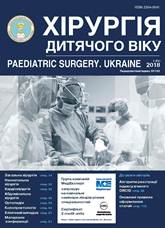Omphalocele and gastroschisis: comparison of outcome in a resource limited tertiary centre
DOI:
https://doi.org/10.15574/PS.2018.59.32Keywords:
Neonates, Omphalocele, Gastroschisis, outcomeAbstract
Background. Neonates with gastroschisis are expected to have better prognosis than omphalocele as the latter is commonly associated with other congenital anomalies. But in our centre, we experience the opposite scenario regarding outcome.The aim of this study was to compare the outcome of these two conditions and to some extent to identify the factors influencing the consequences.
Methods. It was a prospective observational study done at Dhaka Shishu (Children) Hospital from June 2017 to November 2017. All neonates admitted with omphalocele and gastroschisis during the study period were included. Data were collected in a structured questionnaire.
Results. Total number of cases were 38 (24 omphalocele & 14 gastroschisis). None of the patients were antenatally diagnosed. Gender, mean birth weight, mean gestational age, maternal age and mode of delivery demonstrated inconsiderable influence on the outcome. Out of 24 patients with omphalocele, in 20 patients, it was associated with other anomalies, and the other 4 patients died before evaluation. Mortality rate was significantly higher in gastroschisis (86%) than with omphalocele (42%).
Conclusion. Inadequate perinatal management contributes to the poorer prognosis of gastroschisis in our centre. Antenatal diagnosis, planned delivery and appropriate management in immediate post natal period can improve the result of these conditions.
References
Klein MD. (2012). Congenital defects of the abdominal wall. In: Coran AG, Adzick NS, Krummel TM, Laberge J, Shamberger RC, Caldamone AA(eds.). Pediatric Surgery. 7th ed. Elsevier, Philadelphia: 973-84. https://doi.org/10.1016/B978-0-323-07255-7.00075-1; PMid:23002978
Mutanen A, Koivusalo A, Pakarinen M. (2017, Oct 4). Complicated Gastroschisis Is Associated with Greater Intestinal Morbidity than Gastroschisis or Intestinal Atresia Alone. European journal of Pediatric Surgery. https://doi.org/10.1055/s-0037-1607198.
Bergholz R, Boettcher M, Reinshagen K, Wenke K. (2014, Oct). Complex gastroschisis is a different entity to simple gastroschisis affecting morbidity and mortality-a systematic review and meta-analysis. J Pediatr Surg. 49(10): 1527-32. https://doi.org/10.1016/j.jpedsurg.2014.08.001.
Kong JY, Yeo KT, Abdel Latif ME, Bajuk B, Holland AJ, Adams S et al. (2016). Outcomes of infants with abdominal wall defects over 18 years. Journal of Pediatric Surgery. 51: 1644-49. https://doi.org/10.1016/j.jpedsurg.2016.06.003; PMid:27364305
Abdur-Rahman LO, Abdulrasheed NA, Adeniran JO. (2011). Challenges and outcomes of management of anterior abdominal defects in a Nigerian tertiary hospital. African Journal of Pediatric Surgery. 8(2): 159-63. https://doi.org/10.4103/0189-6725.86053; PMid:22005356
Hwang PJ, Kousseff BG. (2004). Omphalocele and gastroschisis: an18 year review study. Genetics in Medicine. 6(4): 232-36. https://doi.org/10.1097/01.GIM.0000133919.68912.A3; PMid:15266212
Watanabe S, Suzuki T, Hara F, Yasui T, Uga N, Naoe A. (2017). Omphalocele and gastroschisis in newborns: over 16 years of experience from a single clinic. J Neonat Surg. 6: 27. https://doi.org/10.21699/jns.v6i2.530; PMid:28770124 PMCid:PMC5538593
Hasan MS, Ferdous KMN, Aziz A, Ali A, Biswas PK. (2017). Outcome of Gastroschisisin a Developing Country: Where to Focus? Global Journal of Medical Research: I Surgeries and Cardiovascular System. 17(1): 24-28
Quirk JG, Fortney J, Collins H B, West J, Hassad SJ, Wagner C. (1996). Outcome of newborns with gastroschisis: the effects of mode of delivery, site of delivery and interval from birth to surgery. American Journal of Obstetrics and Gynecology. 174: 1134-38. https://doi.org/10.1016/S0002-9378(96)70655-5
Driver CP, Bianchi BA, Doig CM, Dickson AP, Bowen J. (2000). The contemporary outcome of gastroschisis. Journal of Paediatric Surgery. 35(12): 1719-23. https://doi.org/10.1053/jpsu.2000.19221; PMid:11101722
Rankin J, Dillon E, Wright C. (1999, Jul). Congenital anterior abdominal wall defects in the north of England, 1986-1996: occurrence and outcome. Prenat Diagn. 19(7): 662-8. https://doi.org/10.1002/(SICI)1097-0223(199907)19:7<662::AID-PD607>3.0.CO;2-C
Loane M, Dolk H, Bradbury I et al. (2007, Jul). Increasing prevalence of gastroschisis in Europe 1980-2002: a phenomenon restricted to younger mothers? Paediatr Perinat Epidemiol. 21(4): 363-9. https://doi.org/10.1111/j.1365-3016.2007.00820.x; PMid:17564594
Halim A, Dewaz JE, Biswas A, Rahman F, White S, van den Broek N. (2016, Aug 1). When, where, and why are babies dying? Neonatal death surveillance and review in Bangladesh. PLOS ONE. https://doi.org/10.1371/journal.pone.0159388.
Downloads
Issue
Section
License
The policy of the Journal “PAEDIATRIC SURGERY. UKRAINE” is compatible with the vast majority of funders' of open access and self-archiving policies. The journal provides immediate open access route being convinced that everyone – not only scientists - can benefit from research results, and publishes articles exclusively under open access distribution, with a Creative Commons Attribution-Noncommercial 4.0 international license(СС BY-NC).
Authors transfer the copyright to the Journal “PAEDIATRIC SURGERY.UKRAINE” when the manuscript is accepted for publication. Authors declare that this manuscript has not been published nor is under simultaneous consideration for publication elsewhere. After publication, the articles become freely available on-line to the public.
Readers have the right to use, distribute, and reproduce articles in any medium, provided the articles and the journal are properly cited.
The use of published materials for commercial purposes is strongly prohibited.

